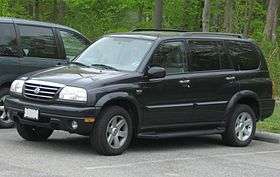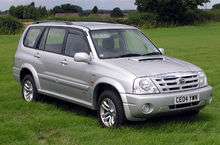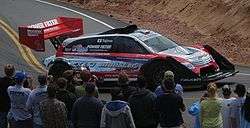Suzuki XL-7
| Suzuki XL-7 | |
|---|---|
 | |
| Overview | |
| Manufacturer |
Suzuki (1998–2006) CAMI Automotive General Motors (2006–2009) |
| Production | 1998–2009 |
| Powertrain | |
| Transmission | 5-speed automatic |
The Suzuki XL-7 (styled as XL7 for the second generation) is Suzuki's mid-sized SUV that was made from 1998 to 2009, over two generations. It was slotted above the Grand Vitara in Suzuki's lineup.
First generation (XL-7; 1998–2006)
- See also Suzuki Escudo second generation
| First generation | |
|---|---|
 | |
| Overview | |
| Also called |
Suzuki Grand Vitara XL-7 (Europe), Suzuki Grand Escudo XL-7 (Japan) (Indonesia) |
| Production | 1998–2006 |
| Model years | 1999–2006 |
| Assembly |
Hiroshima, Japan, Bekasi, Indonesia ( Suzuki Indonesia) |
| Body and chassis | |
| Class | Mid-size SUV |
| Layout | Front engine, rear-wheel drive / four-wheel drive |
| Related |
Suzuki Escudo Suzuki Grand Vitara Maruti Grand Vitara Chevrolet Tracker Chevrolet Vitara XL-7 |
| Powertrain | |
| Engine |
2.5 L 116 kW (156 hp) and 213 N·m (157 lb·ft) V6 (Indonesia) 2.7 L 138kw (185hp) V6 |
| Dimensions | |
| Wheelbase | 110.2 in (2,799 mm) |
| Length |
187.4 in (4,760 mm) (2002–06) 183.6 in (4,663 mm) (1998-01) |
| Width | 70.1 in (1,781 mm) |
| Height |
68.0 in (1,727 mm) 67.5 in (1,714 mm) |
The first-generation XL-7 was a Suzuki design and was essentially a stretched Grand Vitara. It had a Suzuki-designed 2.7-liter V6 on a rear wheel drive-based platform with optional four wheel drive. When introduced, the XL-7 was the least expensive SUV available with three-row seating in North America. The Suzuki XL-7 sold over 20,000 a year, and was awarded the Consumer's Digest Best Buy award. However, sales slowed as the vehicle age relative to the competition.
_wagon_(2010-02-24)_02.jpg)

A unique trait in the U.S. market in this segment, the XL-7 was available with five-speed manual transmission, in both five- and seven-Seat variants.
Second generation (XL7; 2006–2009)
| Second generation (Suzuki XL7) | |
|---|---|
 | |
| Overview | |
| Production | 2006–2009 |
| Model years | 2007–2009 |
| Assembly |
Hiroshima, Japan Ingersoll, Ontario, Canada |
| Body and chassis | |
| Class | Mid-size crossover SUV |
| Layout | Transverse front-engine, front-wheel drive / all-wheel drive |
| Platform | GM Theta platform/GMT193 |
| Related |
Chevrolet Equinox Pontiac Torrent Saturn Vue Opel Antara |
| Powertrain | |
| Engine | 3.6 L 252 hp (188 kW) V6 |
| Dimensions | |
| Wheelbase | 112.4 in (2,855 mm) |
| Length | 197.2 in (5,009 mm) |
| Width | 72.2 in (1,834 mm) |
| Height | 68.9 in (1,750 mm) |
Introduced in November 2006, Suzuki partnered with General Motors to build the 2007 model year version, now called XL7 (without the hyphen). It used the same unibody platform and many of the same components as the Chevrolet Equinox, Pontiac Torrent, Saturn Vue and Opel Antara but incorporated third row seating exclusive to the Suzuki. The second generation model used a version of the GM High Feature engine, built in Japan and shipped to CAMI Automotive in Ingersoll, Ontario, Canada, where the XL7 was assembled with the Equinox and Torrent, and also the second-generation Suzuki XL7 is Suzuki's second entry in the crossover SUV segment, after the second generation Suzuki Grand Vitara. Styling cues on the 2007 model include a chrome slotted grille and trapezoidal headlights.

In May 2009, Suzuki halted production of the XL7 indefinitely due to low demand.[1] Through May 10, 2009, CAMI Automotive Inc. had only produced four XL7s for Suzuki after producing more than 12,000 units the previous year. Suzuki engine designation N36A.
References
- ↑ Ross, Jeffrey N. (2009-05-13). "Suzuki Halts Production of XL7 Crossover". Autotropolis.com. Retrieved 2009-05-13.
External links
| Wikimedia Commons has media related to Suzuki XL-7. |
| ||||||||||||||||||||||||||||||||
| Suzuki automobile timeline, European market, 1980s–present | ||||||||||||||||||||||||||||||||||||||
|---|---|---|---|---|---|---|---|---|---|---|---|---|---|---|---|---|---|---|---|---|---|---|---|---|---|---|---|---|---|---|---|---|---|---|---|---|---|---|
| Type | 1980s | 1990s | 2000s | 2010s | ||||||||||||||||||||||||||||||||||
| 0 | 1 | 2 | 3 | 4 | 5 | 6 | 7 | 8 | 9 | 0 | 1 | 2 | 3 | 4 | 5 | 6 | 7 | 8 | 9 | 0 | 1 | 2 | 3 | 4 | 5 | 6 | 7 | 8 | 9 | 0 | 1 | 2 | 3 | 4 | 5 | |||
| City car | Alto | Alto | Alto | Alto | Alto | |||||||||||||||||||||||||||||||||
| Wagon R+ | Wagon R+ | Splash | ||||||||||||||||||||||||||||||||||||
| Supermini | Swift | Swift | Swift | |||||||||||||||||||||||||||||||||||
| Ignis | ||||||||||||||||||||||||||||||||||||||
| Small family car | Baleno | Liana | SX4 | |||||||||||||||||||||||||||||||||||
| S-Cross | ||||||||||||||||||||||||||||||||||||||
| Large family car | Kizashi | |||||||||||||||||||||||||||||||||||||
| Roadster | Cappuccino | |||||||||||||||||||||||||||||||||||||
| Mini SUV | LJ | SJ | Samurai | Jimny | ||||||||||||||||||||||||||||||||||
| Compact SUV | Vitara | Grand Vitara | Grand Vitara | |||||||||||||||||||||||||||||||||||
| Mid-size SUV | XL-7 | |||||||||||||||||||||||||||||||||||||
| Suzuki road vehicle timeline, North America market, 1985–present | ||||||||||||||||||||||||||||||||
|---|---|---|---|---|---|---|---|---|---|---|---|---|---|---|---|---|---|---|---|---|---|---|---|---|---|---|---|---|---|---|---|---|
| Type | 1980s | 1990s | 2000s | 2010s | ||||||||||||||||||||||||||||
| 5 | 6 | 7 | 8 | 9 | 0 | 1 | 2 | 3 | 4 | 5 | 6 | 7 | 8 | 9 | 0 | 1 | 2 | 3 | 4 | 5 | 6 | 7 | 8 | 9 | 0 | 1 | 2 | 3 | 4 | 5 | ||
| Subcompact | Forsa | Swift | Swift | Swift (Mexico) | ||||||||||||||||||||||||||||
| Swift+ (Canada) | ||||||||||||||||||||||||||||||||
| Compact | Esteem | Aerio | SX4 | |||||||||||||||||||||||||||||
| Forenza | S-Cross | |||||||||||||||||||||||||||||||
| Mid-size | Verona | Kizashi | ||||||||||||||||||||||||||||||
| Mini SUV | Jimny / Samurai | X-90 | ||||||||||||||||||||||||||||||
| Sidekick | Vitara | |||||||||||||||||||||||||||||||
| Compact SUV | Grand Vitara | Grand Vitara | ||||||||||||||||||||||||||||||
| Mid-size SUV | XL-7 | XL7 | ||||||||||||||||||||||||||||||
| Pickup | Equator | |||||||||||||||||||||||||||||||
| Note: Suzuki left the U.S. auto market in 2012 and Canada in 2013. It remains in Mexico. | ||||||||||||||||||||||||||||||||